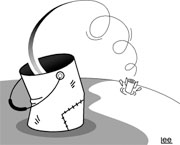Rocket science

Last year, a Korean movie about the singijeon was made. The singijeon was a high-tech weapon of its time during the reign of King Sejong of the Joseon Dynasty, about one century after the fei-huo-chiang. Among various models, a large singijeon was 5.3 meters long. At the tip of an arrow, a container of gunpowder was attached instead of an arrowhead, and the arrow was fired from a movable launcher. A powder keg with high-quality gunpowder served as a warhead; 100 arrows could be launched at once, making it a multi-rocket launch system. It has been said that the weapons were positioned near the border along the Yalu River.
In 1993, a mid-scale singijeon was restored to what it must have looked like in the past and launched at the opening ceremony of the Daejeon Expo. It was possible to restore the rocket from a drawing that has been preserved, unlike other ancient rockets. With its 200-meter range, this singijeon must have once been able to scare away invaders across the Aprok River. Although the singijeon was not the first rocket in the world, it can be regarded as the oldest rocket to be restored.
The German-made V-2 rocket, which proved powerful during World War II, is regarded as the origin of modern rockets. The V-2 could carry a warhead of up to 1 ton and fly 360 kilometers. From 1942 to 1945, more than 3,000 were fired on England, killing 2,754 and injuring 6,523.
Commander Reginald Victor of England’s Royal Aircraft Establishment reckoned that English politicians were psychologically bewildered by the German rockets and feared the 1-ton bomb carried by a rocket evoked much more than the 5-ton bombs carried by aircraft. The V-2 rocket has since become a prototype for today’s rockets launched into space and ballistic missiles.
Pyongyang endeavored to launch a satellite but its rocket failed to enter orbit. One feels helpless hearing that Pyongyang spent a huge amount of money that could have been used to buy grain to quell its people’s food shortage on a scrap of metal, which has sunk to the bottom of the ocean. It was hard to believe one’s ears when a North Korean ambassador to Britain refuted criticism, saying, “Can’t a poor country try space exploration?”
King Sejong, who developed the singijeon, in contrast, never made his people go hungry.
The writer is a deputy political news editor of the JoongAng Ilbo.
By Yeh Young-june [yyjune@joongang.co.kr]










with the Korea JoongAng Daily
To write comments, please log in to one of the accounts.
Standards Board Policy (0/250자)